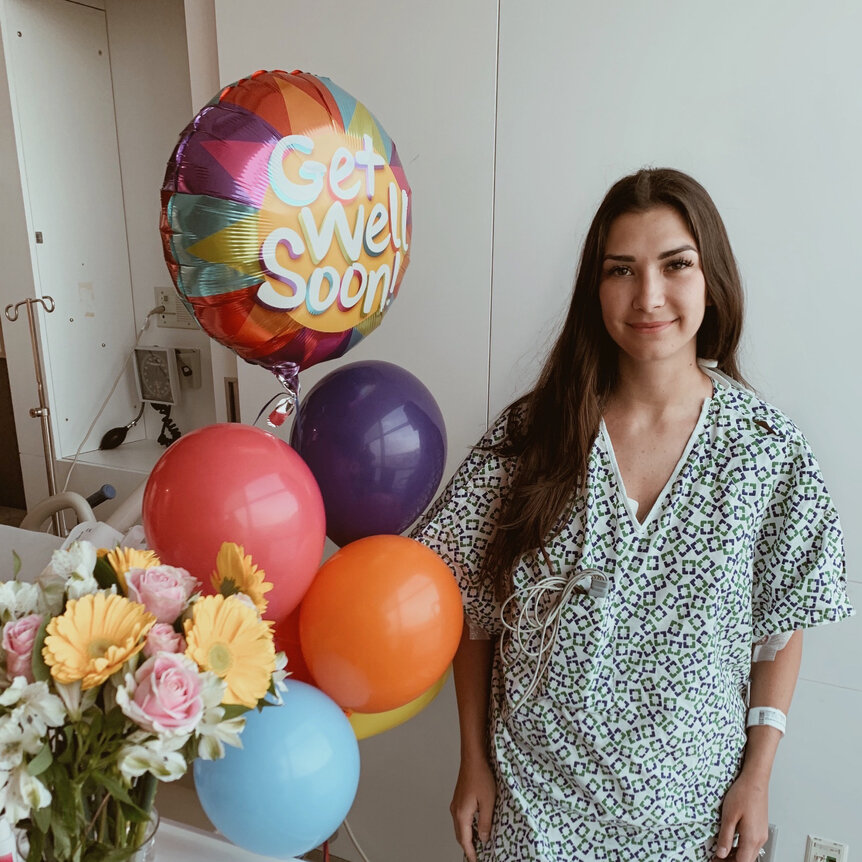From my head to my heart
I was at work, sitting at my desk, when it happened. It was 9:40 a.m.
First, my heart felt like it was skipping a few beats. This was followed by the sudden sensation of someone hammering nails into my chest. I thought I was having a panic attack.
It was 4 p.m. when I finally felt concerned enough to go to urgent care. Although these “episodes” happened often, only recently (in the last year) have they lasted for more than 12 hours. And not only that, but they would occur when I wasn’t even doing any physical activity. How scary is that?! Not to mention, the pain would take over my whole body and impact my ability to perform daily tasks.
*disclaimer: this is not normal for my condition, so if this is you, please please please see a cardiologist.
You see, as someone with a Type A (plus plus plus) personality, anxiety is a friendly foe. I overthink, overload + overwhelm myself by chasing perfection in all areas of my life. As such, it is not uncommon to experience the following symptoms: chest tightness, rapid heartbeat, emotional unease. These also are symptoms of Supraventricular Tachycardia (SVT). It took me a year paired with being told my heart rate was measured at 180 bpm to realize something more serious was going on, and to seek appropriate help.
Pre-procedure
After I saw the cardiologist, I wore a heart monitor for two weeks to track my heartbeat, during which I experienced one short episode. Next, I met with an electrophysiologist to discuss the results of the heart monitor. The scariest part was hearing that I actually experienced three episodes in total, two of which I didn’t even feel happening. The conclusion was Atrioventricular Nodal Reentry Tachycardia (AVNRT), which basically means I had an extra circuit in my heart’s pathways that was messing up the signaling, thus causing irregular heartbeat.
I also had to have multiple EKGs & ECHO tests completed to determine my heart’s movement.
Next, the electrophysiologist (Dr. Wazni at the Cleveland Clinic), told me my options were to either take medication or have an ablation. If I were to go with the first option, I wouldn’t be able to take the medication if and when pregnant, and with my condition, I would be prone to having more frequent episodes, which would heavily impact the baby. That paired with my dislike for medicine, I decided to go with the second option.
Procedure
I was escorted into an EP Lab, where I was put on a table without general anesthesia. Because the doctor needed my heart to function normally, I was only given muscle relaxer to stay awake during the procedure. Then, my groin area was numbed, followed by three catheters (they look like cable cords) being inserted through the veins towards my heart. Honestly, I could 100% feel the catheters being inserted, which was painful. Once the catheters were in the right place, I was given adrenaline to stimulate a would-be episode. While not always successful on the first try, this shows the team where the problem area may be. The identified area is then lasered off and I was given a 30-minute break to let my heart settle. To ensure the laser was successful and no other areas could pose a threat, I was given adrenaline a second time.
Cardiac ablation is a procedure to scar or destroy tissue in your heart that’s allowing incorrect electrical signals to cause an abnormal heart rhythm.
Post-procedure
Although the doctor said my heart was good to go 24 hours post procedure, my recovery took about a week due to the groin incisions, which led to a hematoma, or bleeding under the skin. I was at-risk for blood clots as well, which led to a scare a few days after I was discharged because my stubborn self did not take it easy
*I do not recommend driving days after, and you shouldn’t do any heavy lifting + strenuous exercise.
Truth be told, the months leading up to my procedure were some of the hardest. I shed many tears, not because I didn’t trust God’s plan, but because I was afraid of complications and how that would impact my family. In the end, I trusted in Him and surrendered to His mercy. Even when I started to slowly panic during the procedure, I quickly calmed down because I felt His presence.
Patients with AVNRT are often branded as having panic attacks or anxiety disorders due to the duration of the tachycardia, according to The Cardiology Advisor. If this resonates with you, schedule a visit to the doc to avoid misdiagnosing yourself. Your anxiety could lead to something more serious.
I want to thank the staff at the Cleveland Clinic for taking amazing care of me, pre- and post-procedure. I also want to thank my family and friends for devoting their time to pray with me and be there for me. Lastly, I’d like to thank those that took the time to visit and pass along their well wishes. I couldn’t have done it without the incredible support system behind me and without God.
xx,
Karolina


